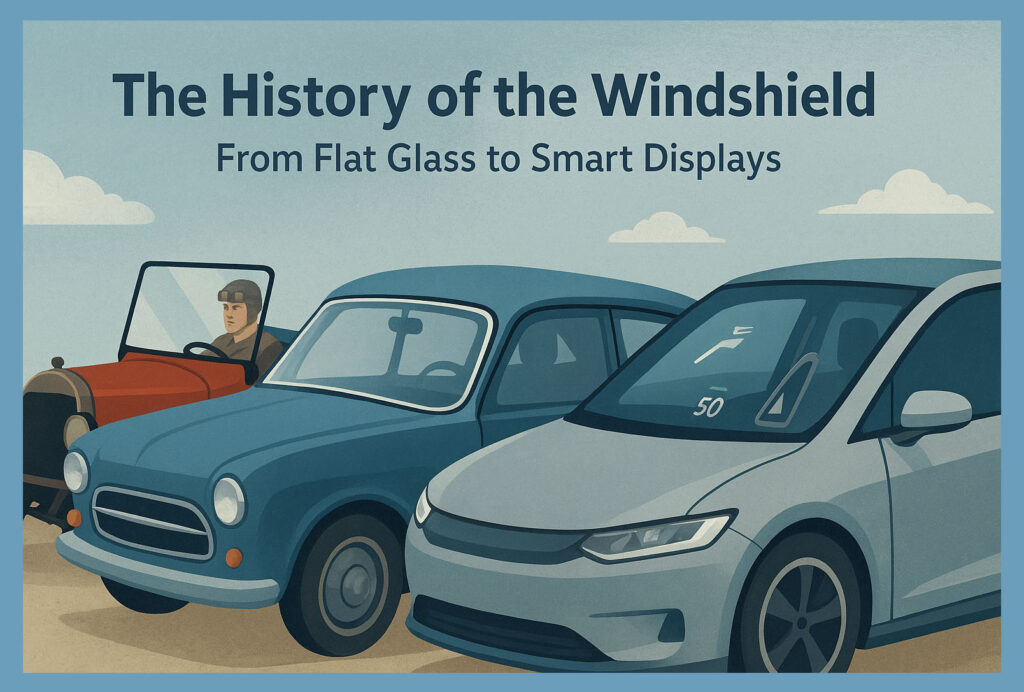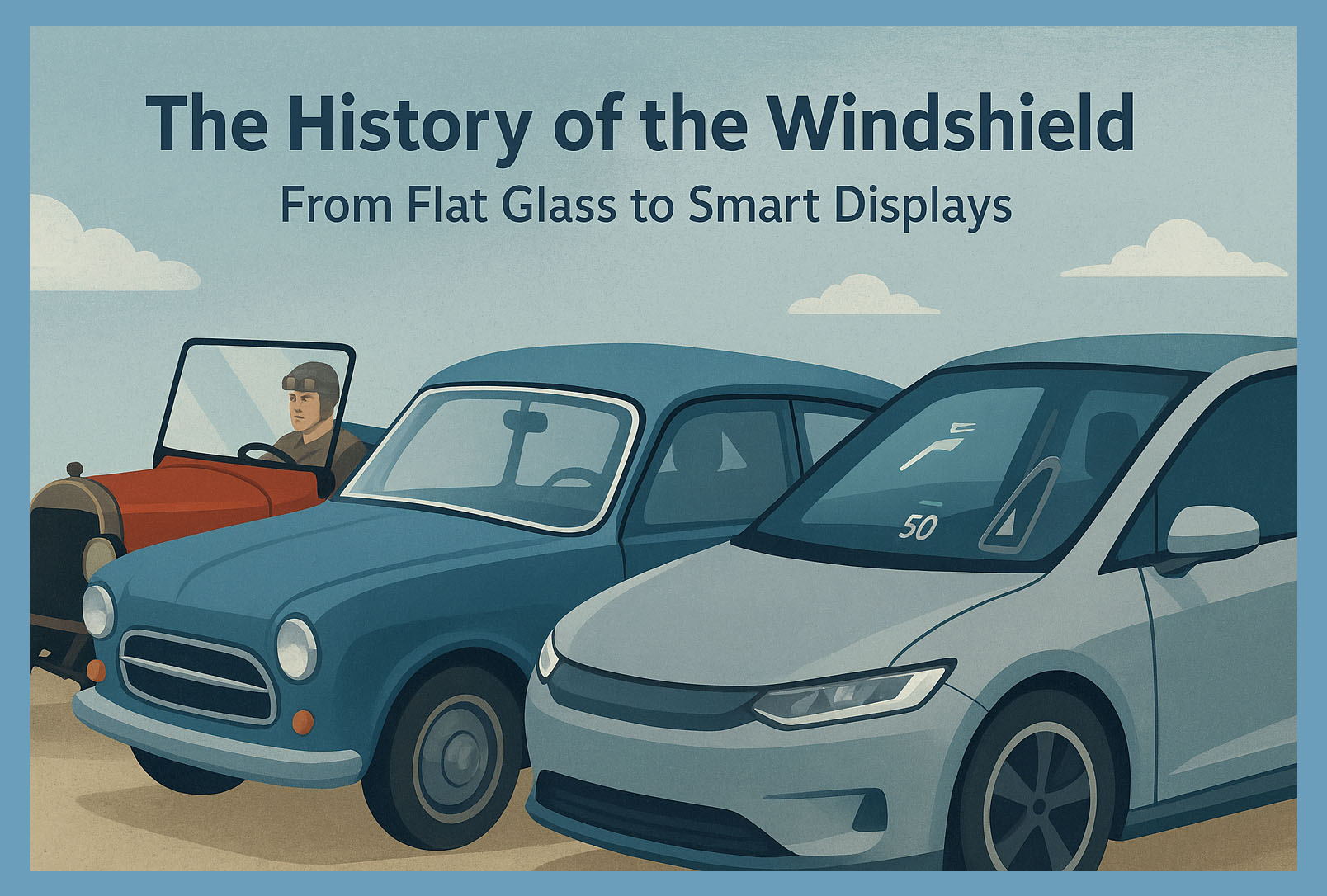The Humble Beginnings: Flat Glass and Open-Air Motoring
In the earliest days of the automobile, around the late 1800s and early 1900s, drivers didn’t even have windshields. Cars were open-air machines, and operators often wore goggles or scarves to protect themselves from dust, insects, and debris.
By the 1910s, simple flat glass panes became standard on many vehicles. These early windshields were essentially the same type of glass used in homes, clear but fragile. When struck by a stone or involved in an accident, they could shatter into dangerous, razor-sharp shards. This lack of safety soon prompted innovation, and brought us a step closer to the modern windshield.
The Birth of Safety Glass: A Fortunate Discovery
The first major leap in windshield technology came by accident. In 1903, French chemist Édouard Bénédictus dropped a glass flask coated inside with cellulose nitrate. He noticed that while the glass cracked, it didn’t shatter. This discovery inspired the development of laminated safety glass, which became the foundation for modern windshields.
By the late 1920s, Ford Motor Company began using laminated glass in their vehicles. This new type of glass consisted of two layers of glass bonded by a thin layer of clear plastic (polyvinyl butyral, or PVB). When impacted, the plastic layer held the glass together, reducing the risk of injury.
Curves, Style, and Strength: The Mid-20th Century Evolution
By the 1950s, car design was booming—and so was windshield technology. Manufacturers introduced curved windshields, improving aerodynamics and aesthetics while giving drivers a wider field of vision.
Tempered glass, another form of safety glass, also became popular for side and rear windows. It was heat-treated to improve strength and designed to shatter into small, less dangerous pieces. However, laminated glass remained the gold standard for front windshields because of its ability to stay intact upon impact.
The 1980s and 1990s: Windshields Become Structural
As vehicle engineering advanced, so did the role of the windshield. No longer just a window, it became an integral part of the vehicle’s structural integrity. Properly installed windshields began contributing to roof support, helping to prevent collapse in rollover accidents.
Around this time, urethane adhesives replaced traditional gaskets, creating a stronger bond between glass and frame. This not only improved safety but also reduced wind noise and leaks, offering drivers a quieter, more comfortable experience.
The 2000s: The Rise of ADAS and Technological Integration
In the early 2000s, windshields started to go digital. Advanced Driver Assistance Systems (ADAS), such as lane departure warning, automatic emergency braking, and adaptive cruise control, relied on sensors and cameras often mounted directly to the windshield.
This ushered in a new era where replacing a windshield wasn’t just about the glass, it required precise calibration to ensure the vehicle’s cameras and sensors worked properly. What was once a simple replacement became a high-tech procedure requiring expert equipment and certification.
The 2020s: Smart Glass and Augmented Reality Displays
Today’s most advanced vehicles, especially electric and luxury models—are transforming the windshield into a digital display hub. Technologies such as augmented reality (AR) head-up displays (HUDs) project navigation directions, speed, and hazard alerts directly onto the glass, allowing drivers to keep their eyes on the road.
Some EVs, like the Mercedes EQS and Lucid Air, use panoramic “pillar-to-pillar” glass for both visibility and design appeal. Others experiment with smart tinting and solar integration, allowing the glass to adjust light levels or generate power.
As automakers continue to blend form, function, and technology, the windshield is no longer a passive piece of glass—it’s becoming an intelligent interface between driver and machine.
The Future: Self-Healing, Solar, and AI-Assisted Windshields
Looking ahead, researchers are developing self-healing glass capable of repairing small cracks on its own, as well as solar-embedded windshields that could power in-vehicle electronics. Artificial intelligence could soon allow the windshield to analyze road conditions in real-time, providing live safety feedback to drivers.
What started as a flat pane of fragile glass has evolved into one of the most complex and essential components of the modern vehicle.
Need a Windshield Replacement? Compare Local Shops for Free
Whether you drive a vintage car with a flat windshield or a new model equipped with ADAS sensors and smart glass, replacing your windshield correctly is crucial for safety and performance. At Glass.net, you can use our free quote tool to compare up to three trusted auto glass shops near you. Get fast, accurate estimates and choose the best local professionals, so your vehicle’s glass, old-school or high-tech, is in the right hands.

To read more, visit blog.glass.net

